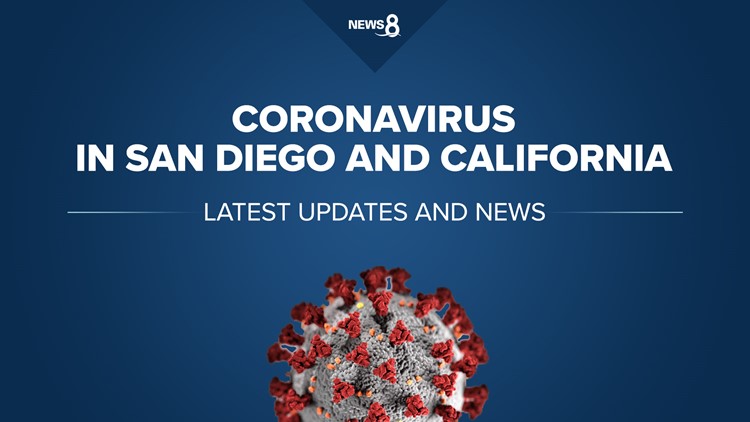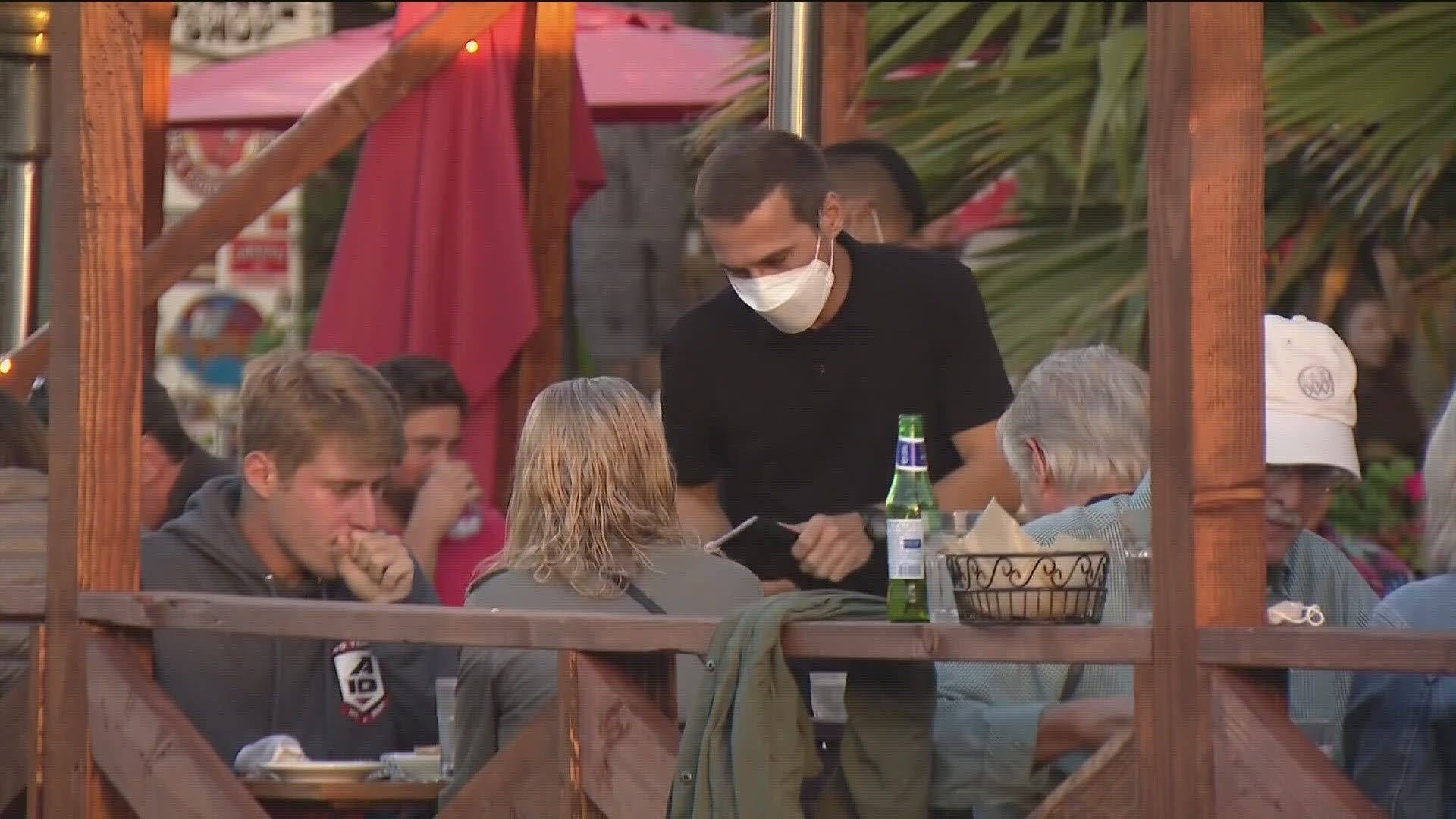SAN DIEGO COUNTY, Calif. — Editor’s note: This story shows updates about the coronavirus outbreak in San Diego and California from Aug. 16 - 18 (afternoon), 2020. Click here for real-time updates for Aug. 18, 2020 and on.
Key COVID-19 facts in San Diego and California:
- There are 35,162 confirmed cases in San Diego County and 633 reported deaths.
- There are 632,667 confirmed cases in California and 11,342 reported deaths.
- View San Diego County cases by zip code or city and find local testing sites.
- Click here for previous updates
Aug. 18
San Diego County removed from state monitoring list
San Diego County was removed from California's monitoring list on Tuesday. The county will now need to report a case rate below 100 cases per 100,000 people for an additional 14 days. Then, all schools grades K-12 can reopen with safety modifications. The county reported 15 community outbreaks over the last week, which is still above the predetermined trigger of seven outbreaks in a week. The county reported 202 new confirmed COVID-19 cases and seven new deaths on Tuesday, meaning the 14-day rolling average percentage of positive cases is 4.1%.
Mayor Faulconer to sign executive order allowing worship and workouts in city parks
As the region waits for clarity on when it is coming off the state’s COVID-19 watchlist and seeks guidance on how falling off the list will affect existing bans on local activities, Tuesday morning Mayor Kevin L. Faulconer will move forward with new solutions to help struggling San Diegans. Faulconer will be joined by City Councilmember Chris Cate and local businesses to announce an executive action that helps gyms and religious institutions use City of San Diego park space for safe outdoor operations.
The executive order comes as public health experts continue to promote outside settings and physical distancing as two key tools to help slow the spread of COVID-19.
To watch the news conference, click here.
Aug. 17
San Diego school districts await watch list decision
The state has reviewed its data and determined that San Diego County’s three-day metric of fewer than 100 cases per every 100,00 residents started Aug. 15 and it’s anticipated to end Monday. That means the region could be off the monitoring list on Tuesday, Aug. 18, and the 14-day period for schools to reopen could begin.
San Diego State University adapts move-in week amid pandemic
An annual rite of passage for many high school graduates is getting underway this week. Move-in day as San Diego State University begins Tuesday and will be unlike any the university has seen before.
SDSU is adapting move-in week due to the coronavirus pandemic with fewer students coming in over staggered dates and times.
San Diego County eyeing end of state's watch list
In a briefing on Monday, the county announced 282 new confirmed cases. The county did not report any new deaths. The countywide 14-day rolling average of positive cases is 4.2%.
Gov. Newsom gives update on COVID-19, California heatwave
On Sunday, Newsom met with members of the California Independent System Operator, California Public Utilities Commission, California Energy Commission, Governor's Office of Emergency Services and senior administration officials.
In a letter written after the meeting, the governor said the blackouts were called Friday and Saturday without notice and demanded an investigation.
"Residents, communities and other governmental organizations did not receive sufficient warning that these de-energizations could occur. Collectively, energy regulators failed to anticipate this event and to take necessary actions to ensure reliable power to Californians," Newsom wrote. "This cannot stand. California residents and businesses deserve better from their government."
Newsom provided an update at noon, adding that San Diego County is likely to be removed from the state's monitoring list on Tuesday.
San Diego Foundation grants $100,000 to new National City Chamber Foundation
The $100,000 grant came from the COVID-19 Community Response Fund at The San Diego Foundation. The grant enables the NCCF to operate workforce development and economic resiliency programs through Jan. 31, 2021.
The NCCF is campaigning for a matching contribution to extend services beyond that date.
Aug. 16
San Diego County teachers prepare for school year whether virtual or in-person
San Diego officially met the criteria on Friday to be removed from the state’s monitoring list and if the county’s COVID numbers stay under the trigger points for the next 12 days, then schools could possibly open for in-person learning by the end of the month.
San Diego County continues reporting positive COVID-19 trends
For the fifth day in a row, San Diego County public health officials reported a case rate of fewer than 100 positive COVID-19 tests per 100,000 people Sunday -- however, the state said it will have to review the data before removing the county from its monitoring list.
Previously, county and state officials had said if the rate stays below 100 per 100,000 people (it was 91.9 Sunday) for three consecutive days, the county would officially be removed from that list. After an additional 14 consecutive days below that number, K-12 schools could potentially reopen for in-person teaching, depending on individual school district metrics.
Some 48 elementary schools have filed waivers with the county to return to school early.
That timeline is now uncertain, as are the specifics of reopening certain businesses for indoor operations.
View all News 8 coverage of coronavirus / COVID-19
News 8 has joined forces with The San Diego Foundation to raise immediate, emergency funds for our most vulnerable neighbors in need. Here is how you can help.
BACKGROUND:
On February 11, 2020 the World Health Organization announced an official name for the disease that is causing the 2019 novel coronavirus outbreak, first identified in Wuhan China. The new name of this disease is coronavirus disease 2019, abbreviated as COVID-19. In COVID-19, "CO" stands for "corona," "VI" for "virus," and "D" for disease. Formerly, this disease was referred to as “2019 novel coronavirus” or “2019-nCoV”.
There are many types of human coronaviruses including some that commonly cause mild upper-respiratory tract illnesses. COVID-19 is a new disease, caused by a novel (or new) coronavirus that has not previously been seen in humans.
Currently, there is no vaccine, however, the CDC suggests the following precautions, as with any other respiratory illness:
Know how it spreads:
- The best way to prevent illness is to avoid being exposed to this virus.
- The virus is thought to spread mainly from person-to-person.
- Between people who are in close contact with one another (within about 6 feet).
- Through respiratory droplets produced when an infected person coughs, sneezes or talks.
- These droplets can land in the mouths or noses of people who are nearby or possibly be inhaled into the lungs.
- Some recent studies have suggested that COVID-19 may be spread by people who are not showing symptoms.
Protect yourself and others
Wash your hands often
- Wash your hands often with soap and water for at least 20 seconds especially after you have been in a public place, or after blowing your nose, coughing, or sneezing.
- It’s especially important to wash:
- Before eating or preparing food
- Before touching your face
- After using the restroom
- After leaving a public place
- After blowing your nose, coughing, or sneezing
- After handling your cloth face covering
- After changing a diaper
- After caring for someone sick
- After touching animals or pets
- If soap and water are not readily available, use a hand sanitizer that contains at least 60% alcohol. Cover all surfaces of your hands and rub them together until they feel dry.
- Avoid touching your eyes, nose, and mouth with unwashed hands.
Avoid close contact
- Inside your home: Avoid close contact with people who are sick.
- If possible, maintain 6 feet between the person who is sick and other household members.
- Outside your home: Put 6 feet of distance between yourself and people who don’t live in your household.
- Remember that some people without symptoms may be able to spread virus.
- Stay at least 6 feet (about 2 arms’ length) from other people.
- Keeping distance from others is especially important for people who are at higher risk of getting very sick.
Cover your mouth and nose with a cloth face cover when around others
- You could spread COVID-19 to others even if you do not feel sick.
- The cloth face cover is meant to protect other people in case you are infected.
- Everyone should wear a cloth face cover in public settings and when around people who don’t live in your household, especially when other social distancingmeasures are difficult to maintain.
- Cloth face coverings should not be placed on young children under age 2, anyone who has trouble breathing, or is unconscious, incapacitated or otherwise unable to remove the mask without assistance.
- Do NOT use a facemask meant for a healthcare worker. Currently, surgical masks and N95 respirators are critical supplies that should be reserved for healthcare workers and other first responders.
- Continue to keep about 6 feet between yourself and others. The cloth face cover is not a substitute for social distancing.
Cover coughs and sneezes
- Always cover your mouth and nose with a tissue when you cough or sneeze or use the inside of your elbow and do not spit.
- Throw used tissues in the trash.
- Immediately wash your hands with soap and water for at least 20 seconds. If soap and water are not readily available, clean your hands with a hand sanitizer that contains at least 60% alcohol.
Clean and disinfect
- Clean AND disinfect frequently touched surfaces daily. This includes tables, doorknobs, light switches, countertops, handles, desks, phones, keyboards, toilets, faucets, and sinks.
- If surfaces are dirty, clean them. Use detergent or soap and water prior to disinfection.
- Then, use a household disinfectant. Most common EPA-registered household disinfectants will work.
Monitor your health daily
- Be alert for symptoms. Watch for fever, cough, shortness of breath, or other symptoms of COVID-19.
- Especially important if you are running essential errands, going into the office or workplace, and in settings where it may be difficult to keep a physical distance of 6 feet.
- Take your temperature if symptoms develop.
- Don’t take your temperature within 30 minutes of exercising or after taking medications that could lower your temperature, like acetaminophen.
- Follow CDC guidance if symptoms develop.
The California Department of Public Health has issued guidance on the use of cloth face coverings to protect against the spread of the novel coronavirus COVID-19.
As of April 4, 2020, all employees in San Diego County who may have contact with the public in any grocery store, pharmacy/drug store, restaurant or food establishments, convenience store or gas station are required to wear a cloth face covering while at work as an additional measure to help “flatten the curve” in the San Diego region.
As of May 1, San Diego County requires everyone in the county to wear face coverings in many public settings. The coverings help prevent the spread of COVID-19 and are part of our path to reopening San Diego. See full health order here.
While officials say these face coverings are not a substitute for practices like social distancing and handwashing, there is evidence to suggest that the use of cloth face coverings by the public during a pandemic could help reduce disease transmission. Officials do not recommend the public use N-95 or surgical masks which are needed by health care workers and first responders.



